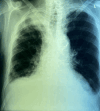Peritoneal Dialysis As Salvage Therapy in a High-Risk Patient With Failed Hemodialysis Access: A Case Report
- PMID: 40709159
- PMCID: PMC12289300
- DOI: 10.7759/cureus.86681
Peritoneal Dialysis As Salvage Therapy in a High-Risk Patient With Failed Hemodialysis Access: A Case Report
Abstract
Peritoneal dialysis (PD) is often contraindicated in patients with extensive prior abdominal surgeries due to the risk of adhesions, catheter malposition, and poor dialysis efficacy. We present a complex case of a 64-year-old male with end-stage kidney disease (ESKD) who experienced repeated arteriovenous fistula (AVF) thromboses and multiple catheter-related bloodstream infections, ultimately exhausting all viable vascular access sites for hemodialysis (HD). Despite prior abdominal surgeries, the patient underwent successful PD catheter insertion following femoral catheter-related sepsis and fungemia. Although initial PD catheter malposition was observed, it was corrected surgically, and PD was initiated, leading to full clinical recovery. This case highlights the potential role of PD as a rescue therapy, even in patients with relative contraindications and no remaining HD access options. It underscores the importance of reconsidering the feasibility of PD in high-risk patients when vascular access is no longer available.
Keywords: bacteriemia; central venous catheter infection; end-stage kidney disease; hd (hemodialysis); hemodialysis access; peritoneal dialysis (pd).
Copyright © 2025, Gajić et al.
Conflict of interest statement
Human subjects: Informed consent for treatment and open access publication was obtained or waived by all participants in this study. Ethics Committee of The University Clinical Center of Serbia issued approval No. 890/8. Conflicts of interest: In compliance with the ICMJE uniform disclosure form, all authors declare the following: Payment/services info: All authors have declared that no financial support was received from any organization for the submitted work. Financial relationships: All authors have declared that they have no financial relationships at present or within the previous three years with any organizations that might have an interest in the submitted work. Other relationships: All authors have declared that there are no other relationships or activities that could appear to have influenced the submitted work.
Figures



References
-
- Guidelines for laparoscopic peritoneal dialysis access surgery. Haggerty S, Roth S, Walsh D, et al. Surg Endosc. 2014;28:3016–3045. - PubMed
Publication types
LinkOut - more resources
Full Text Sources
Research Materials
